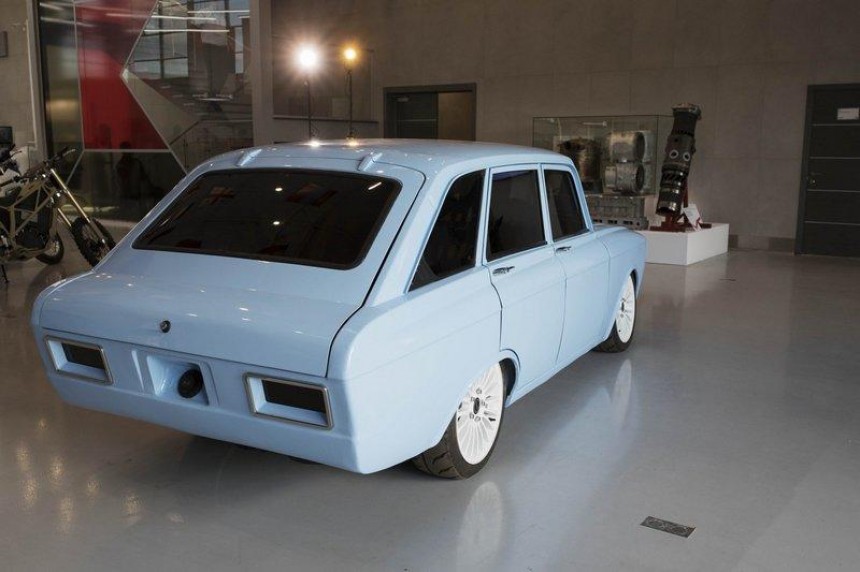It's been said that when Mikhail Kalashnikov, creator of the AK-47, met Eugene Stoner, inventor of the AR-15, the two didn't even need to speak the same language to convey how highley each of them thought of the other's designs.
We can only wonder how old man Kalashnikov would have reacted to seeing his famous last name across the trunk of an electric car. That perceived reaction probably would have happened had he lived long enough to see the Kalashnikov CV-1 electric car in the flesh. As we celebrate EV month, let's take a deep dive into the electric concept car designed by the same team as the AK-47.
We're sure you have a few questions. First of all, why? Just, why did anybody think this was a good idea. The AK-47 rifle is supposed to destroy stuff, not sustain the environment in which it's built. Well, as it happens, there's a bit more precedence behind the idea than you might first think. Anyone with even a passing understanding of Cold War communism understands that cars were special privileges for the societal elite for most of the 20th century in the Eastern Bloc.
One such Soviet car from this time was the Moskvitch 408. A car manufactured in the same factory, right alongside AK-47s before production ceased at the Russian factory in 1976. The Moskvich was an absolutely dreadful car by all but the most barebones Soviet point of view, in spite of its production taking place adjacent to what many call greatness.
We must admit that many moons and years have passed since the pitiful Moskvich trundled out of the Kalashnikov Factory. Automotive production standards have risen exponentially since then, even in some of the most impoverished places in the world. So who's to say Kalashnikov couldn't do a better job building a car with nearly five decades of technological advancement behind it?
We can only be led to assume Kalashnikov themselves thought the same thing. Because back in the year 2018, they unveiled a creation they called the CV-1. While the Tesla Model 3 was doing to the EV space what the iPhone did to smartphones, this was the Russian response. As we all know, no one does cheap and cheerful better than Ex-Soviets.
So then, you probably think what's on offer doesn't look all that impressive. In fairness, it's easy to get the wrong idea about the CV-1 on first impression. Rest assured, the modern-day Kalashnikov is a far different company than in the days of the original AK. Until 2013, the company that bears the Kalashnikov Group name today was known as the Izhevsk Machine-Building Plant.
They're best known for being the largest firearms manufacturer in all of Russia. Building everything from pistols to sniper rifles, and of course, the upgraded AK-74M. But what's lesser-known to most westerners is Kalashnikov's contributions to the UAV and military robot industry. These ventures undoubtedly come in handy when designing something like, say, an electric car.
But it doesn't take a genius to realize the CV-1 EV is a fully paid-up member of the retro styling club. In this case, the derivative design is the Moskvitch 1500 family estate car, approximately the size of an American mid-sized station wagon. That's right, a cousin of the very same 408 sedans built alongside the original production AK-47s. The car was also known as the IZh 2125 "Kombi" (short for "combination" in Russian) when built under license by Lada Izhevsk.
In place of the Kombi's puny four-cylinder engine, this new-age take on its design sported a 90-kWh battery-powered electric motor. Good for an alleged 680 horsepower and similar amounts of torque. Good for zero to 60 miles per hour in around six seconds. At the 2018 weapons and technology expo outside Moscow, where the CV-1 was unveiled, Kalashnikov lauded a maximum electric range of 220 or so miles.
Granted, that sounds pretty pathetic compared to what Tesla, Porsche, Ford and General Motors have done with EV technology since 2018. But for all the claims of bringing the fight to western automakers, communications from the CV-1 team have been pretty darn quiet in the last four years. Not the least bit helped by the disastrous events of the last five weeks in Eastern Europe.
In the context of the Russian-Ukrainian war, it's easy to see the CV-1 as a piece of propaganda and little more. One can only hope it can be a launching point for more sustainable EV technology in Eastern Europe in the near future. Rather than an eco-friendly Twitter buzz machine devised to gain short-term clicks for a national auto industry desperate to be taken seriously. Also, would it hurt you to not have a 100% limo tint? It's like they're trying to hide something.
Check back for more from EV month right here on autoevolution.
We're sure you have a few questions. First of all, why? Just, why did anybody think this was a good idea. The AK-47 rifle is supposed to destroy stuff, not sustain the environment in which it's built. Well, as it happens, there's a bit more precedence behind the idea than you might first think. Anyone with even a passing understanding of Cold War communism understands that cars were special privileges for the societal elite for most of the 20th century in the Eastern Bloc.
One such Soviet car from this time was the Moskvitch 408. A car manufactured in the same factory, right alongside AK-47s before production ceased at the Russian factory in 1976. The Moskvich was an absolutely dreadful car by all but the most barebones Soviet point of view, in spite of its production taking place adjacent to what many call greatness.
We must admit that many moons and years have passed since the pitiful Moskvich trundled out of the Kalashnikov Factory. Automotive production standards have risen exponentially since then, even in some of the most impoverished places in the world. So who's to say Kalashnikov couldn't do a better job building a car with nearly five decades of technological advancement behind it?
So then, you probably think what's on offer doesn't look all that impressive. In fairness, it's easy to get the wrong idea about the CV-1 on first impression. Rest assured, the modern-day Kalashnikov is a far different company than in the days of the original AK. Until 2013, the company that bears the Kalashnikov Group name today was known as the Izhevsk Machine-Building Plant.
They're best known for being the largest firearms manufacturer in all of Russia. Building everything from pistols to sniper rifles, and of course, the upgraded AK-74M. But what's lesser-known to most westerners is Kalashnikov's contributions to the UAV and military robot industry. These ventures undoubtedly come in handy when designing something like, say, an electric car.
But it doesn't take a genius to realize the CV-1 EV is a fully paid-up member of the retro styling club. In this case, the derivative design is the Moskvitch 1500 family estate car, approximately the size of an American mid-sized station wagon. That's right, a cousin of the very same 408 sedans built alongside the original production AK-47s. The car was also known as the IZh 2125 "Kombi" (short for "combination" in Russian) when built under license by Lada Izhevsk.
Granted, that sounds pretty pathetic compared to what Tesla, Porsche, Ford and General Motors have done with EV technology since 2018. But for all the claims of bringing the fight to western automakers, communications from the CV-1 team have been pretty darn quiet in the last four years. Not the least bit helped by the disastrous events of the last five weeks in Eastern Europe.
In the context of the Russian-Ukrainian war, it's easy to see the CV-1 as a piece of propaganda and little more. One can only hope it can be a launching point for more sustainable EV technology in Eastern Europe in the near future. Rather than an eco-friendly Twitter buzz machine devised to gain short-term clicks for a national auto industry desperate to be taken seriously. Also, would it hurt you to not have a 100% limo tint? It's like they're trying to hide something.
Check back for more from EV month right here on autoevolution.







